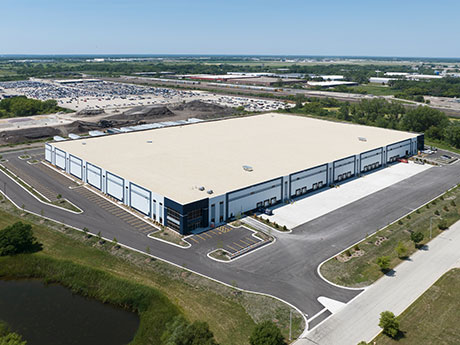By John Cassidy and Calvin Gunn, Lee & Associates
If you love a good groundbreaking photo — full of shiny shovels, hard hats and smiling development teams — you may be disappointed this year, for all the best reasons. With Chicago’s most recent wave of speculative industrial projects currently being delivered, the market now actually has space to offer industrial tenants — a refreshing change from the past few years.
With construction costs and interest rates continuing to rise and credit availability shrinking, many developers with ties to Chicago are pausing new projects as exit cap rates are becoming more difficult to predict. At the same time, market fundamentals are starting to cool from the pandemic-era eruption of demand. The good news: Chicago’s industrial market may be down from the clouds, but it’s still historically quite healthy.

Vacancy rate in perspective
According to Lee & Associates of Illinois’ second-quarter industrial snapshot, construction deliveries caused the Chicago industrial vacancy rate to tick upward for the second consecutive quarter. However, a 3.68 percent vacant market is still considered a historically low vacancy environment. As a comparison, that vacancy rate measured about 12 percent at the end of 2009 and 6.6 percent in the second quarter of 2020, just before industrial demand spiked, driven in part by e-commerce demand and supply chain challenges.
In the second quarter of this year, new leasing activity in the Chicago area totaled 8.1 million square feet, a nominal 2.7 percent decrease from the 8.3 million square feet of leases signed during the first quarter. Seven new leases greater than 300,000 square feet were signed during the second quarter, up from six leases in the previous quarter. Unilever’s 1.1 million-square-foot lease at 2250 Berens Court in New Lenox was the largest completed lease of the second quarter.

User sales, although decreasing 5.1 percent from the prior quarter, remained healthy as 34 building sales were completed. There is a noteworthy lack of properties available for sale, particularly in that sweet spot of buyer demand for facilities measuring between 50,000 to 100,000 square feet. Owners in this size range take note: Your property values are increasing due to lack of supply.
Spec projects dot the map
As noted in the Lee & Associates report, 14.3 million square feet of new construction projects have been completed year-to-date, and 93 percent of those projects are speculative versus build-to-suit. The mid-year total already surpasses the speculative deliveries in all of 2021 and is only slightly behind the totals from 2019 and 2020.
Build-to-suit (BTS) construction in Chicago hit its 10-year high of 11.1 million square feet in 2022; by contrast, BTS activity has been nearly non-existent in 2023. This sharp decline is largely driven by high construction costs and the fact that it’s much more economical to build and lease a speculative building without expensive customization.
While BTS languishes, speculative buildings are coming on line at a rapid pace. The second quarter alone brought 28 speculative projects totaling 6.3 million square feet. The three largest, totaling nearly 2 million square feet, are located in the Southeast Wisconsin market, with the remainder located mostly in the big box markets of I-80 and I-55.
The largest second-quarter speculative completion was a 1 million-square-foot building at 10322 140th Ave. in Bristol, Wisconsin, which was built by NorthPoint Development and pre-leased by Uline in the third quarter of 2022. However, not all of the new speculative development in the Southeast Wisconsin market has scored a massive pre-lease deal, as noted by the market’s vacancy rate of 7.76 percent, the highest of all Chicago-area submarkets, yet still not considered historically high.
Costs, economic uncertainty
Rider Levett Bucknall’s index of Chicago-area construction costs noted that Chicago-area construction costs increased 9.2 percent from April 2022 to April 2023, the biggest jump among the 12 largest urban cities. This surge has significant implications for developers and owners of industrial properties — not only as it relates to new ground-up development, but for tenant build-out as well.
Chicago is seeing a general slowdown in speculative pre-leasing, as it is no longer as common for deals to be signed prior to construction completion. Among all current under-construction supply, 27 percent remains vacant. On the tenant side, economic uncertainty is causing a general unease about early lease commitments, resulting in more calculated decision making. From the perspective of a landlord or developer, there is a palpable desire to hold out for a full-building user rather than succumb to the high cost of dividing a facility for multiple tenants.
Smaller users: get creative
The disconnect between user demand and available space landlords are willing to lease is causing the continuation of a severe shortage of options, despite the vacant space available. High demand amongst mid-sized tenants continues, so these 50,000- to 100,000-square-foot users may need to think outside of the box. Some good news for these tenants: Sublease space is on the rise. In the second quarter, available sublease space increased to 6.5 million square feet, up from 4.3 million square feet one year ago. The O’Hare market alone has roughly 2.7 million square feet of sublease space on the market.
In a classic “win-win” scenario, tenants early in their lease terms can gain a new income stream because of the drastic escalation in rental rates, while users suffering from a lack of available product can open their universe of options. Because of low direct vacancy, subleases should be absorbed. A BTS for sale could be another option should construction costs begin to normalize.
Carbon and conversions
As the world continues the race to alleviate effects of climate change, developers, owners and users of industrial real estate will begin to show an increased focus on the sustainable features of the buildings they construct and occupy. From an owner’s perspective, it is proven that sustainable features like solar panels, high-efficiency lighting, rainwater harvesting and roof insulation lower operating costs and boost an industrial facility’s worth, in many cases demanding a “green premium” of up to 25 percent.
Many users — especially those with large national or global footprints — are actively seeking to reduce their carbon emissions, and their industrial real estate is a prime opportunity to achieve those goals. Fleet, forklift and personal vehicle electrification will require more onsite power and the installation of electric vehicle charging stations. The power needs per building are likely to increase, putting power at more of a premium as time goes on. How power is distributed on a development site will be a crucial decision early in the planning process.
An environmentally friendly option for industrial users may come from a surprising source: the struggling office market. Some developers are using the opportunity to bring more sustainable industrial development to Chicago via adaptive reuse of obsolete office buildings. For office properties sitting on large enough sites, a conversion to industrial use could help bring languishing properties to a new highest and best use while also helping to reduce carbon emissions.
The conversions of well-known office properties in the Chicago area include Atrium Corporate Center in Rolling Meadows and the massive 232-acre Allstate campus in Glenview. The developers of these projects, Brennan Investment Group and Dermody Properties, respectively, are planning to introduce significant green building practices into the projects.
Steady and stable
As we move into the second half of the year, we will be keeping a watchful eye on these developments along with the Chicago industrial market’s bellwether market statistics.
Rental rates and other market fundamentals will return to more historical norms after the whiplash-inducing changes of the past few years. Developers will be weighing carry costs versus subdividing to meet demand. The 77 speculative projects currently under construction will bring 23.6 million square feet of deliveries in the second half of the year and will result in an additional vacancy rate increase at that time.
While demand has slowed somewhat and the vacancy rate has ticked up, our diagnosis for Chicago is steady and stable.
John Cassidy and Calvin Gunn are both principals with Lee & Associates. This article originally appeared in the August 2023 issue of Heartland Real Estate Business magazine.


